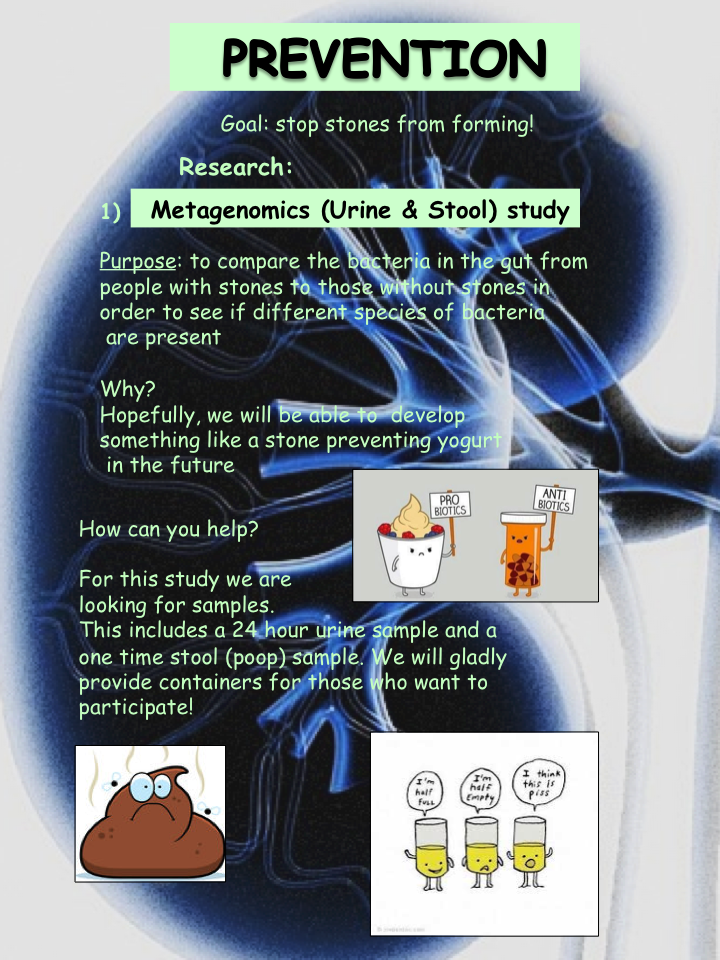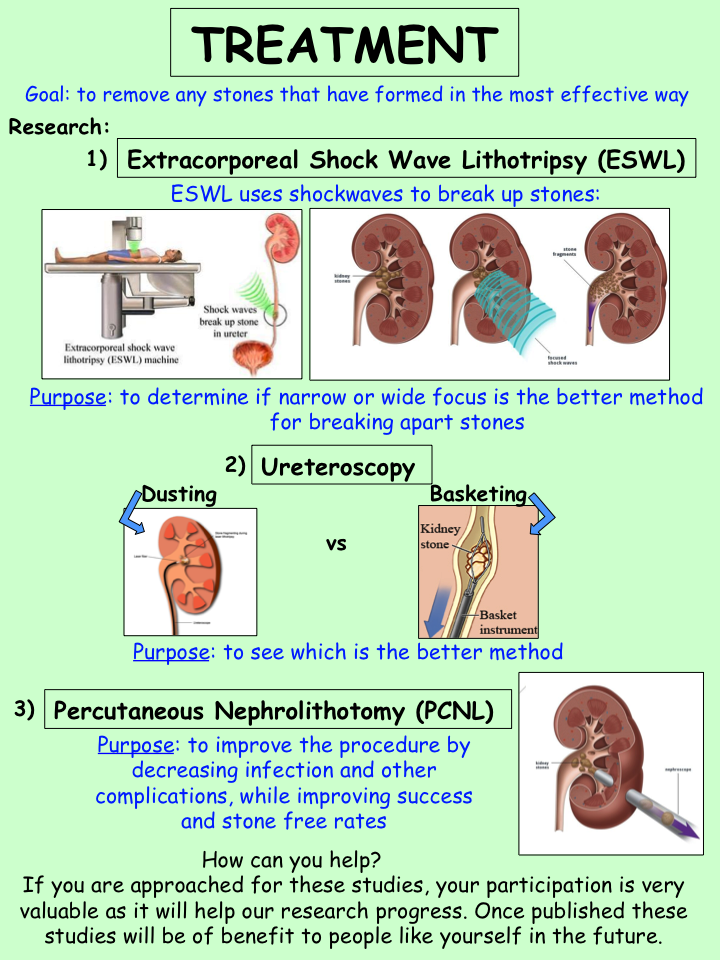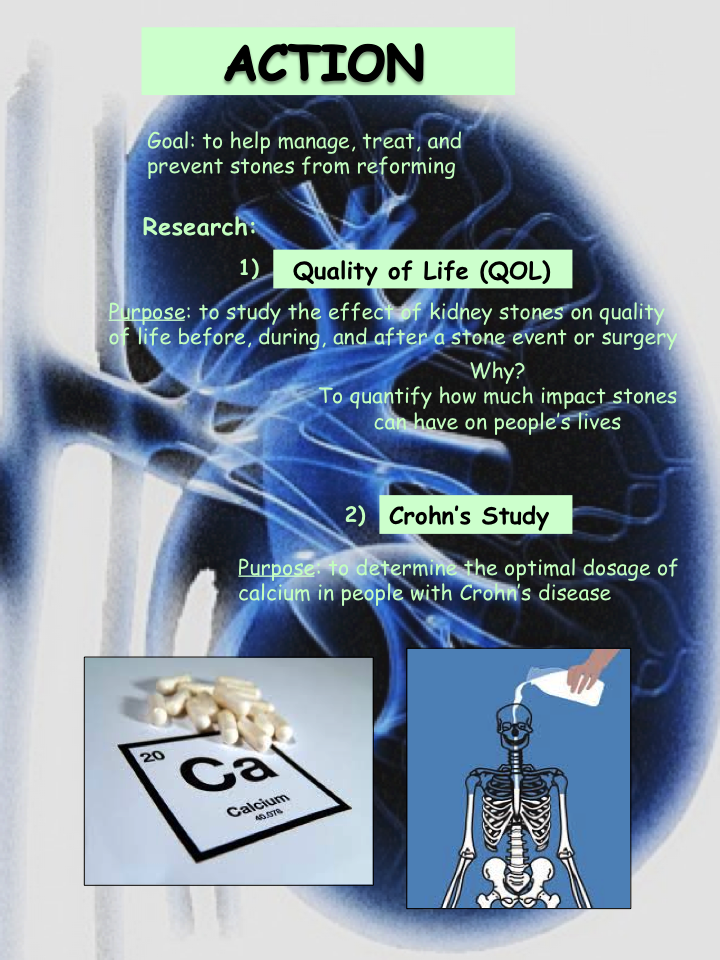Participating in research is voluntary! If you would like to learn more about these trials or are looking to participate in research you can contact the research team via email or phone.
The following is a list of some of our ongoing clinical trials at the Stone Centre:
Stent Survey Study. Ureteral stents (hollow tubes that assist urine from from the kidney to the bladder) can be placed after procedures for treating kidney stones. These stents can cause significant discomfort and the experience may affect decision making for the treatment of future stones. The aim of this survey study is to better understand the factors affecting these decisions, and to be able to appropriately advise patients on their treatment options for kidney stones.
Metabolic Evaluation Questionnaire Study. One of the common tests that urologists use to determine if a patient’s diet is contributing to kidney stone disease is a metabolic work up. This is a test where you collect your urine for 24 hours and then have it analyzed by a lab. The composition of the urine will help the urologist determine if a patient needs to change their diet in order to prevent further stone formation. The purpose of this survey is to determine if metabolic workups are being administered appropriately according the guidelines and criteria established by the Canadian Urologic Association (CUA). Additionally, the survey will try to evaluate whether patients have the results of these tests explained to them adequately and also to measure patient compliance with dietary advice.
Metagenomics Study. This study will examine the different species of bacteria in the large intestine (or gut) of people to compare and see if differences exist between patients who have kidney stones and those who have never had kidney stones. There are already differences in gut bacteria noted in people who are obese versus those who are normal weight. Currently, there is only one gut bacterium that has been identified to help people avoid making further kidney stones. This study will help identify bacterial species to develop as potential new therapies to prevent people from making kidney stones.
Sharklet Catheter Study. Foley catheters are a significant cause of urinary tract infections (UTIs) which are very costly to our healthcare system. Catheters can also have serious medical consequences for patients. This study is testing a novel catheter device that will hopefully repel bacterial colonization to the catheter and therefore reduce the amount of UTIs.
Struvite Antibiotics. Struvite stones or infection stones are a subset of kidney stones. This subset of kidney stones has been under researched, while being quite damaging to renal health of the individual, they form fast and can occupy the whole kidney and reducing its function severely or rendering it nonfunctional, hence requires invasive procedures for its removal. Antibiotics must be utilized to treat the infecting organism that causes the stone so that subsequent infection and stone production can be reduced and hopefully eliminated. With this study we aim to determine an effective antibiotic regimen following definitive surgical therapy of struvite stones.
Antibiotics post percutaneous nephrolithotomy (PCNL). PCNL has become standard of care for large renal stones. While less invasive than prior open techniques, it still is associated with some complication rates, with infectious complications being particularly problematic. Currently physicians in North America follow a guideline that recommends a single dose of antibiotics immediately prior to the procedure, however they do not know if and when additional antibiotics may be necessary, for example in the case of known risk factors for infection. The aim of our study is to determine the role of preoperative antibiotics prior to PCNL in patients at low risk of infectious complications.
Quality of Life (QOL) Questionnaire for stones. The purpose of this study is to evaluate a newly developed questionnaire for kidney stones to evaluate the quality of life in who patients who have had kidney stones. The purpose is to test it across 10 sites and determine how useful it is in measuring health-related quality of life.
IBD Crohn’s and stones. Hospitalization for kidney stones in the Inflammatory Bowel Disease (IBD) population is common, particularly among Crohn’s patients who had a small bowel resection. This patient population experiences a lifetime occurrence of kidney stone formation as high as 25% accompanied with a high rate of recurrence (the typical rate of stone formation is ~10% in the non IBD population). Giving oral calcium is used to bind oxalate in the intestine in an attempt to reduce the amount of oxalate that is absorbed into the body and to reduce urinary oxalate levels. This study’s primary objective is to scientifically define an appropriate calcium supplementation that reduce the level of oxalate found in the urine of patients living with inflammatory bowel disease
Prostatitis. Men with clinically significant prostatitis symptoms account for approximately 3% of Canadian male outpatient visits and causes significant morbidity and cost. Although the etiology of prostatitis is still not clear now, much is thought due to infection of bacteria or other microorganisms. Traditonal methods sometimes are difficult to culture and find out the disease-causing microorganisms. Our study is to examine modern methods for detecting microorganisms if possible to detect microorganisms more accurately than with traditional methods.
SWL dual foci. Shock wave lithotripsy (SWL) is the most common treatment modality for kidney stones. It is a safe and non-invasive treatment performed on subjects under intravenous sedation (light anesthesia) on an out-patient basis (subject goes home the day of the procedure). The lithotripsy generates source shock waves that are then propagated into the body and focused on the kidney stone to fragment it. The lithotripter used at Vancouver General Hospital is an electromagnetic lithotripter with a unique design that allows for a dual focus system with the option of either a narrow (6×28 mm) or wide (9×50 mm) focal zone, depending on the clinical situation. There is no standard of care for setting focal zones for targeting the shock waves produced by the machines. This study is being done in order to compare the single-treatment success rates of narrow and wide focal zones for the shock wave lithotripsy of renal stones.
3-Way PCNL (enrolment completed): The purpose of this study is to compare efficiency, in terms of stone fragmentation and removal time , of three of the newest lithotrites commercially available: the ultrasonic dual probe Cyberwand, the combination pneumatic/ultrasonic Swiss Lithoclast Select, and the CO2 cartridge powered pneumatic stone breaker (used in combination with the ultrasonic Olympus LUS-2 (Olympus, Melville, NY).
Degradable stent (study completed). This is a prospective, single-arm, single center research study to evaluate the preliminary safety and efficacy of the unique degradable Uriprene ureteral stent. It is designed to promote the drainage of urine from the kidney to the bladder. Various stents have been developed and perfected over the past 40 years for urinary drainage, however morbidity problems such as discomfort, pain, infection, encrustation still exist. The biodegradable Uriprene stent could overcome some of these limitations of current stents. The stent’s property to desolve, unlike any other stent, offers promising hopes for reducing and/or eliminating these problems. It will hopefully improve comfort and eliminate the need for secondary procedures for patients to have their stents removed.
Discoloured stents (enrolment completed). The aim of this study is to identify the root cause for the significant discolouration of Boston Scientific Percuflex based stents observed in some patients, particularly those from Japan. We will also test and compare them to stents from Canadian patients. Furthermore, we will determine whether the discolouration promotes bacterial adhesion and/or encrustation of the stent.
Bacterial Analysis of Kidney Stones Removed by PCNL (enrolment completed). While certain compositions of kidney stones are known to be caused by bacterial infection in the kidney, the association between bacteria and kidney stones in patients that do not have clinical signs or symptoms of infection is not well understood. Previous studies have found bacteria present in stone samples from patients who did not have an active infection. It is unknown whether the bacteria that may be present in non-infection kidney stones are causing the kidney stones or if they are simply growing in the kidney stones after they form. We hope to address this question by removing bacteria that may be present in kidney stones of patients enrolled in this study and trying to grow kidney stones with these bacteria in the presence of different solutions.
URS Dusting vs. Basketing (enrolment completed): Flexible ureteroscopy (URS) is a commonly employed treatment for patients with urinary stones less than 2 cm in size. Through a flexible endoscope, stones are typically either fragmented into small pieces and extracted using a basket device or the stone is simply lasered into small pieces of dust that will pass out of the kidney on its own. Urologists will choose to either fragment and basket a stone or laser it into dust. This study will evaluate whether patients are more likely to have their stone removed more efficiently with one technique versus the other.



Please note this list of research projects open to enrollment may change at any time. All of the projects that involve active prospective participation have been also posted on clinicaltrials.gov. For the most accurate and up-to-date information, please contact the Stone Centre research team here.
